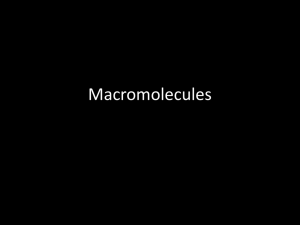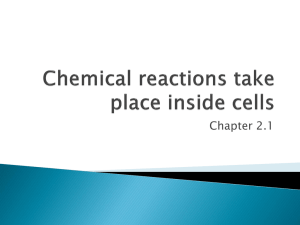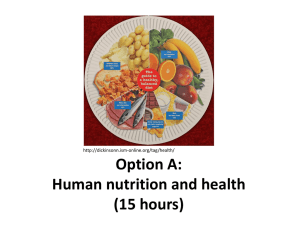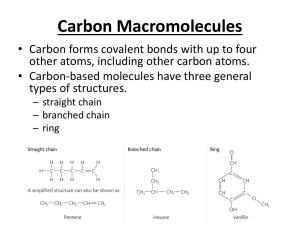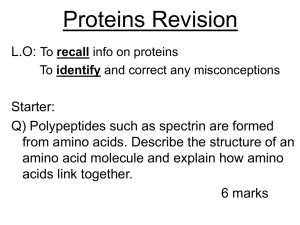Lecture 4
advertisement
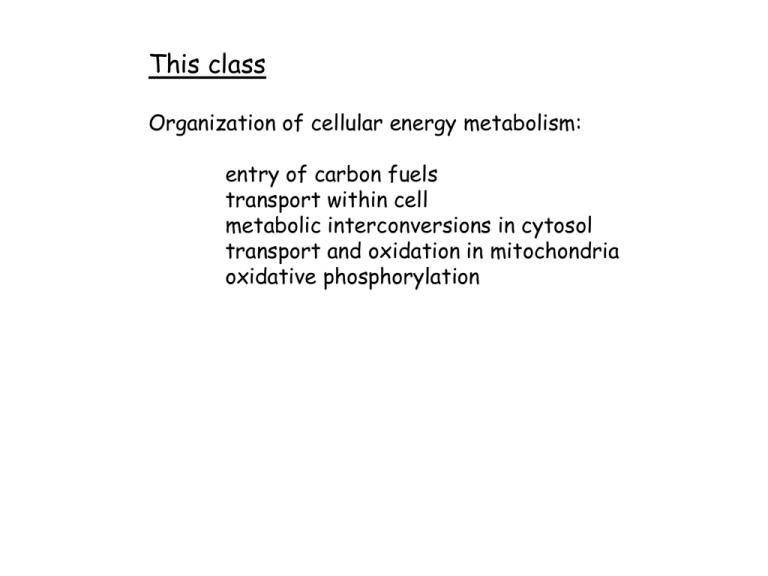
This class Organization of cellular energy metabolism: entry of carbon fuels transport within cell metabolic interconversions in cytosol transport and oxidation in mitochondria oxidative phosphorylation Energy Metabolism Which type(s) of cells produce energy? Energy Metabolism Why do we need constant input of energy? Energy Metabolism 3 major metabolic fuel types: Carbohydrate (glucose) Protein (amino acids) Lipids (fatty acids) 1. Entry of carbon fuels: plasma membrane transport glucose amino acids fatty acids 1. Entry of carbon fuels: plasma membrane transport glucose GLUT amino acids fatty acids 1. Entry of carbon fuels: plasma membrane transport GLUT4 in isolated adipocytes 1. Entry of carbon fuels: plasma membrane transport GLUT protein isoforms Same basic structure 13 members (isoforms) now recognized Differ in tissue specificity, kinetic properties (including sensitivity to insulin) 1. Entry of carbon fuels: plasma membrane transport glucose GLUT amino acids fatty acids 1. Entry of carbon fuels: plasma membrane transport glucose GLUT amino acids fatty acids 1. Entry of carbon fuels: plasma membrane transport glucose amino acids fatty acids GLUT ? Fatty acid transport – plasma membrane Fatty acid transport via an ATP-driven pump? 1. Entry of carbon fuels: plasma membrane transport • Glucose – specific transporters (GLUT) • Amino acids – diffusion and/or transporters (many!) • Fatty acids – still unknown! 2. Transport within the cell glucose GLUT amino acids fatty acids 2. Transport within the cell glucose GLUT glucose Glucose-6P amino acids fatty acids 2. Transport within the cell glucose amino acids GLUT glucose Glucose-6P amino acids fatty acids 2. Transport within the cell glucose amino acids fatty acids GLUT glucose Glucose-6P amino acids Fatty acid binding protein (FABP) 2. Transport within the cell • Glucose – soluble; trapped by conversion to G-6P • Amino acids – diffusion/transport • Fatty acids - FABP 3. Metabolic interconversions in the cytosol GLUT glucose Glucose-6P amino acids Fatty acids 1 glucose ↓ 2 pyruvates 3. Metabolic interconversions in the cytosol GLUT glucose Glucose-6P 2x pyruvate amino acids Fatty acids 3. Metabolic interconversions in the cytosol GLUT glucose Glucose-6P (2x) pyruvate mitochondria amino acids lactate Fatty acids 3. Metabolic interconversions in the cytosol GLUT glucose Glucose-6P amino acids Fatty acids 3. Metabolic interconversions in the cytosol GLUT glucose Glucose-6P amino acids Transamination deamination Oxidation of carbon skeleton Fatty acids 3. Metabolic interconversions in the cytosol GLUT glucose Glucose-6P Fatty acids amino acids Acyl-CoA synthetase Fatty acyl-CoA 3. Metabolic interconversions in the cytosol • Glucose: • Amino acids • Fatty acids: → pyruvate → trans/deamination → fatty acyl-CoA → lactate → oxidation 4. Import into mitochondria & catabolism Pyruvate transport & catabolism Import of fatty acids into mitochondria Catabolism in the mitochondrial matrix Catabolism in the mitochondrial matrix 4. Import into mitochondria & catabolism pyruvate → PyrC → PDH → TCA amino acids: many fatty acids → CPT → β-ox → TCA Organization and compartmentalization of fuel catabolism - summary The mitochondrion – energy transduction central How does it work? http://www.sci.sdsu.edu/TFrey/MitoMovie.htm The (in)efficiency of oxidative phosphorylation Proton leak: potential) Non-ohmic (v. high leak at high membrane Purpose of proton leak? Why isn’t ox-phos more efficient? Purpose of proton leak? Heat production? Purpose of proton leak? Heat production? (only in some cases) Functions of UCPs UCP1 - Only in mammals - Only in brown adipose tissue – heat production Functions of UCPs Other UCPs - Ubiquitous (nearly; including ectotherms) – prevent membrane potential getting to high? Purpose of proton leak? Heat production? (only in some cases) Reduce production of reactive oxygen? Rapid rest to work transitions (idling speed)? Inefficiency of oxidative phosphorylation Proton leak Present in mitochondria from all organisms (including ectotherms) Substantial (~20% of cellular MR) Basal rate of leak increased by protein catalysts (UCPs) in some cell types Metabolic organization of animal cells • Regulated membrane transport of energy substrates • Protein-mediated intracellular transport of some energy substrates • Mitochondrial membrane transporters • TCA cycle as a central node in catabolic pathways • Proton motive force and ATP synthesis • Inefficiency of ox-phos Next week: Finish reading chapter 3 Read posted review




